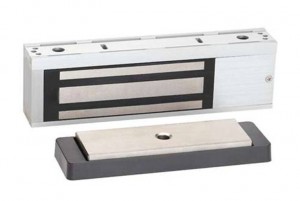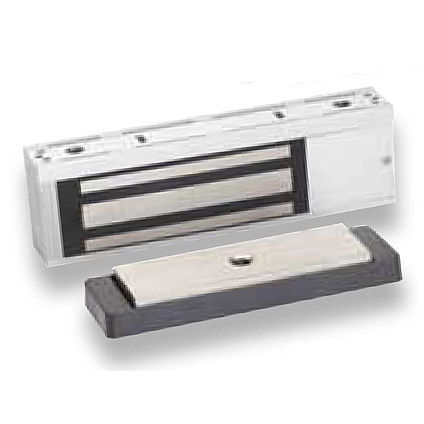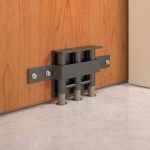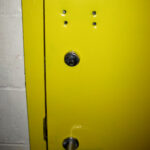This article was published in the February 2012 issue of the Locksmith Ledger:
 An electromagnetic lock is essentially an electromagnet in a housing mounted on the door frame, and a steel armature mounted on the door. When the magnet is energized, it bonds to the armature and locks the door. To allow access or egress, a switch must be provided to de-energize the magnet.
An electromagnetic lock is essentially an electromagnet in a housing mounted on the door frame, and a steel armature mounted on the door. When the magnet is energized, it bonds to the armature and locks the door. To allow access or egress, a switch must be provided to de-energize the magnet.
Prior to the 2009 edition of the International Building Code (IBC), the set of code requirements typically used for doors equipped with electromagnetic locks was the section called Access-Controlled Egress Doors. The 2009 edition added a second set of requirements that could be used, called Electromagnetically Locked Egress Doors. Either of these two sets of requirements can now be used, depending on the application.
The basic difference between these two sections is that the original section, Access-Controlled Egress Doors, required a sensor and push button as release devices, while the new section, Electromagnetically Locked Egress Doors, allows a door-mounted release device instead. This could be panic hardware or a latchset with a request-to-exit (RX) switch, or a bar with an electronic touch sensor.
Here is a summary of the requirements for both sections from the 2009 IBC:
1008.1.4.4 Access-Controlled Egress Doors
- Applies to entrance doors in a means of egress and entrance doors to tenant spaces.
- Allowed in Use Groups – A (Assembly), B (Business), E (Educational), I-2 (Institutional – Hospitals & Nursing Homes*), M (Mercantile), R-1 (Residential – Hotels, Motels, & Boarding Houses*), and R-2 (Residential – Apartments & Dormitories*).
- A sensor must be mounted on the egress side to detect an occupant approaching the doors. Doors must unlock upon a signal from the sensor or loss of power to the sensor.
- Loss of power to the lock must unlock the doors.
- A manual unlocking device (push button) shall result in direct interruption of power to the lock – independent of the access control system electronics. When the push button is actuated, the doors must remain unlocked for 30 seconds minimum. The push button must include signage stating “Push to Exit” and must be located 40” to 48” vertically above the floor and within 5’ of the doors. Ready access must be provided to the push button.
- If the building has a fire alarm/sprinkler system/fire detection system, activation of the system must automatically unlock the doors. Doors must remain unlocked until the system has been reset.
- Entrance doors in buildings with an occupancy in Group A, B, E or M shall not be secured from the egress side during periods that the building is open to the general public.
1008.1.9.8 Electromagnetically Locked Egress Doors
- Applies to doors in a means of egress and doors to tenant spaces. The 2009 IBC includes a limitation to doors “not otherwise required to have panic hardware,” which was removed in the 2012 edition.
- Allowed in Use Groups – A (Assembly), B (Business), E (Educational), M (Mercantile), R-1 (Residential – Hotels, Motels, & Boarding Houses*), and R-2 (Residential – Apartments & Dormitories*).
- The door must be equipped with listed hardware mounted on the door leaf, which incorporates a built-in switch to directly release the electromagnetic lock and unlock the door immediately.
- The release device must have an obvious method of operation, and must be readily operated with one hand under all lighting conditions.
- Loss of power to the listed hardware must automatically unlock the door.
When the new section was added to the 2009 IBC, the technical committee made a change to the proposed language which caused some confusion. A limitation to doors that are “not otherwise required to have panic hardware” was included in the 2009 edition, but it appears that this was not the intent. The limitation was removed and the intent clarified in the 2012 edition of the IBC, and as long as the switch in the panic bar releases the mag-lock, a door required to have panic hardware can be equipped with a mag-lock.
With the addition of Section 1008.1.9.8 – Electromagnetically Locked Egress Doors, the door-mounted release device can be used instead of the sensor and emergency push button. Note that this section does not require the mag-lock to release upon activation of the fire alarm or sprinkler system when a door-mounted release device is used. But there are a few issues that are still unclear, even with the 2012 changes.
- The door must unlock upon loss of power to the “listed hardware,” which in this case is the door-mounted release device. Loss of power to some types of request-to-exit switches will not unlock the mag-lock. We may see a future change to the language so that loss of power to the electromagnetic lock is required to unlock the door, but the code currently addresses the release device.
- I-2 occupancies (Institutional – Hospitals & Nursing Homes*) are not included as acceptable locations for electromagnetically locked egress doors. This use group was added to the Access-Controlled Egress Doors section in the 2009 edition of the IBC, so hopefully the new section will catch up and include the I-2 use group in the future.
- UL 305, the UL Standard for Panic Hardware, doesn’t address the use of panic hardware to release an electromagnetic lock. There is also a section of the IBC which states that certain doors shall not be equipped with a latch or lock unless it’s panic hardware. This should be changed to reflect the use of a mag-lock released by panic hardware.
For jurisdictions using NFPA 101 – The Life Safety Code, a new section was added in the 2009 edition – 7.2.1.5.5 Electrically Controlled Egress Door Assemblies. The requirements are basically the same as the IBC, but there is no limitation on occupancy types and no restriction related to panic hardware. Keep in mind that state or local requirements could differ from those of the IBC or NFPA 101, so it’s important to be aware of the codes in your project’s jurisdiction. Refer to the published codes for the detailed code requirements, and consult the Authority Having Jurisdiction for more information about the local codes.
*Refer to Chapter 3 of the International Building Code for a complete description of these use groups.
You need to login or register to bookmark/favorite this content.






Great info. Thanks. It is interesting that you can use a maglock and a touchbar releasing device with no connection to a fire or sprinkler system and no secondary push button release.
“Loss of power to some types of request-to-exit switches will not unlock the mag-lock” means that you can’t use a normally closed switch in the exit device to release the mag lock. Looks like we need a relay board in the power supply.
Also I see that you can use a maglock in a school if it is controlled by an exit device with an RX switch because the code doesm’t say that “it must not be secured from the egress side while the building is open to the public”
I am getting less confused. Thank you. It is the mark of a great code blogger that you can unconfuse the codes matrix for us ordinary hardware people.
Okay, let me ask a question. Sometimes in ‘code speak’ it is what is ‘not’ said that is equally as important as to what ‘is’ said. In IBC 1008.1.4.4 2009 version it specically uses the term “…entrance doors…”. Those are always “…in the means of egress…”. However, in 1008.1.9.8 (same version), it just uses the term “Doors in the means of egress…”. Now that could mean the ‘entrance doors’ and it could not. Its this new section just describing the use of ‘electromagnetic locks’ in doors that ARE NOT “entrance doors”? If that was the case then it makes more sense why they have the requirements in different sections and why ‘loss of power’ automtically unlocks the door – because that is the ‘egress’side, while the ‘outside’ of the building would remain secure.
Just sayin….. Can you call your ICC buds and float this interp by them? I have a large retailer that is trying to go with the new ‘mag lock’ code on ‘entrance doors’ in a M occupancy, and I’m not sure they can do it. Remember 1008.1.4.4 says “…in accordance with ALL the following criteria (for entrance doors in Mercantile). #6 says “…shall not be secured…”.
Thanks, Jerry
It’s actually a great and helpful piece of information. I’m happy that you simply shared this helpful information with us. Please keep us informed like this. Thanks for sharing.
Dear Lori,
Can you just make it bit clear for me the following as a Electromagnetic locks are only available in fails safe. So automatically lock will be released once the power is gone. Or I don’t get the real issue you intend to explain above. Pls ignore if it is a stupid question
“The door must unlock upon loss of power to the “listed hardware,” which in this case is the door-mounted release device. Loss of power to some types of request-to-exit switches will not unlock the mag-lock. We may see a future change to the language so that loss of power to the electromagnetic lock is required to unlock the door, but the code currently addresses the release device.”
Hi Maharoof –
What I was explaining in the article is that there are two different code sections which address two methods of releasing an electromagnetic lock. One is where the lock is released by a sensor and push button (and the fire alarm and power failure), and the other is where the lock is released by hardware mounted on the door, such as a latchset or panic hardware with an RX switch. With the second type of set-up, the code requires the lock to unlock when power is lost to the door-mounted releasing hardware – the latchset or panic hardware with an RX switch. Some of these releasing devices would typically be wired so they are sending a signal to unlock the door, and in this case, they lock may not unlock if power to the releasing device is lost. It would make more sense to require the lock to unlock upon loss of power to the lock, not loss of power to the releasing device.
– Lori
Dear Lori,
I have a dilemma facing me on a very large overseas airport project under construction. We are following IBC and NFPA 101 for the access control system. However, maglocks have been specified for the ACS openings and I am slowly removing them and going toward electrified hardware. My current issue is with Delayed Egress maglocks. Although, technically they meet the requirements for delayed egress devices, I am trying to prove that a delayed egress exit device will serve the project in a better and more modern manner.
IBC 1008.1.9.7.4 states “relocking shall be by manual means”. I have been searching for a code requirement for the height of the manual relocking function for the delayed egress device. If maglocks are used, then the reset key switch built into the mag lock will be at height between 2.4 and 3 meters AFF. Are you aware of a code requirement limiting the height of the manual relocking(reset) switch for delayed egress devices.
Thank you
Hey Lori,
Do some states require a pneumatic push button on the interior to unlock the maglock?
Hi Dan –
The auxiliary push button has to keep the door unlocked for 30 seconds, independent of the access control system electronics. So it’s not just a regular push button – it has to have the capability of unlocking the door for 30 seconds. A pneumatic button is one option, but the codes do not specifically require it to be pneumatic.
– Lori